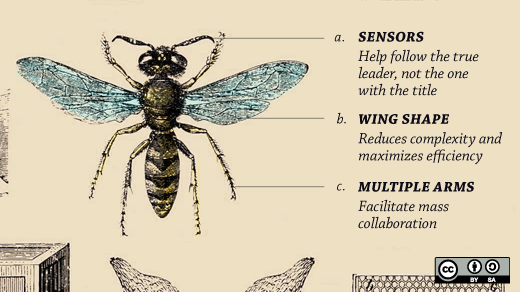A provocative research finding is that 75-90% of all large organizational projects fail to meet their original objectives, (Patterson et al. (2006)). The same research suggests human practices and behaviors—more than technical or financial matters—are at the root of the breakdowns.
Social Network research shows that individuals with a more realistic sense of the organizational networks in which they work lead more effective teams and are more successful in their careers (Krackhardt 1990). This proposed idea ("hack") equips individuals to form a more realistic and saavier sense of their networks and to achieve shared goals more effectively.
We introduce a business "paper-and-pencil" drawing tool where people engage other people in a learning conversation about who influences project success. Derived from social network research and influence analysis, it is a deceptively simple, participatory tool for becoming smarter and more realistic about the people networks in which one is engaged.
For a given problem, participants collaborate to identify:
- stakeholders in the problem
- known links between stakeholders
- stakeholder motivations for/against specific solutions
- their perceived levels of influence on the issue
Diagramming the perceptions of influence around a business problem produces a unique, visible, and valuable form of knowledge—information which is otherwise always fragmented and often hidden in the minds of the stakeholders. This drawing tool provides a structure for diverse individuals to develop a common understanding of the "Outside-In View", as well as, specific opportunities for self-directed, influential actions ("Managing without Managers").
A second surprising benefit of drawing influence networks in groups is how it touches important social motivators which drive participant action. Participant interactions:
- build familiarity (trust) with each other and with the business problem
- reveal participant reasoning styles to each other
- reduce uncertainty around which potential actions will produce greatest alignment or opposition
(See Net-Map or Adlenn for additional details)
Problem
75% of large organizational initiatives, projects and programs fail to meet their original objectives, according to organizational performance research. Analysis suggests human practices and behaviors—more than technical or financial matters—are the most common causes of project breakdowns. (Patterson et al. (2006)).
Top 4 ineffective Business Behaviors found in large projects which fail to achieve their original purpose (Patterson (2006) are:
- Fact-Free Planning: 85% of projects are set up to fail by setting deadlines or resource limits with little consideration for organizational or external realities.
- Failure to align organizational interests: 83% of project experience powerful competitive interests which manipulate or derail program priorities.
- Unmotivated or unequipped team: 80%of projects have team members unwilling or unequipped to support the project optimally.
- Failure to build effective direction-setting alliances: 65% of projects’ organizational commitment & sponsorship is insufficient to achieve the original intended purpose.
There is a fundamental flaw in the ability of most organizations to effectively execute their strategies. All four business behaviors above point to a systemic inability of change leaders to engage with and influence the networks of people they work with.
Sometimes navigating these human systems is scorned as "playing the game of office politics". This inability is worn as a badge of honor. It should not be. Failure to equip staff adequately to discover and address human barriers to organizational effectiveness has huge costs on organizational performance. Projects go over budget or miss deadlines; projects fail to meet quality and required functionality; team morale is damaged; work-life balance suffers.
"Managing without managers" can only succeed if staff are equipped to engage and inspire colleagues and other stakeholders, no matter what the official titles or informal roles are in a business situation. For example, two innovative employees of a global organization, (let’s call them Isabella and Patrick), develop a technical improvement for streamlining customer interactions on-line. However, the full implementation of the innovation is not under their control, but will be influenced by several organizational units and external actors.
Patrick and Isabella recognize that engaging only their direct chain of command is insufficient. They need a tool that helps them identify other core influencers and understand the respective collaborative and competitive motives of each. They also need to find a way of engaging the right influencers to support their proposal.
Solution
The innovators, Patrick and Isabella, proceed by diagnosing the organizational environment using a pen-and-paper approach called "Net-Map". It is a powerful tool which helps people to interactively identify influence networks and depict the information in an intuitive and quantitative manner. Co-participants are able to visualize and evaluate their own networks within the larger group network.
How Collaborative Influencer Mapping (Net-Map) works:
Frame the business challenge as a question to be answered, (e.g. "Who can influence the success of our innovation?") Invite a diverse group of people ranging from one’s own team to other stakeholder groups to have an engaging, learning conversation about the question. Arrange participants in groups from two to twelve people around one large sheet of drawing paper and proceed by asking:
Who are all the Stakeholders (hereafter referred to as "Actors")? Individuals, groups, departments, and/or organizations are identified and written on individual cards and placed the map. In Isabella and Patrick’s case, actors from the organization and an affiliated software company are identified and placed on the map.
How are the actors linked? Participants decide the different kinds of links (e.g. flow of funding, personal friendships, conflicts, hierarchy, knowledge flow etc.) and draw each link type between the actors in a different color. In the Isabella and Patrick’s simple example, positive links are depicted with green, while conflictual links are shown in red.
Actor motivations towards the goal? The group then explores the goals and motivations of each actor. In this case, the color of the box next to the actors represent whether they support (green) or oppose (red) the proposed innovation.
Perceived level of Influence by Actor on the goal? The size of icons are adjusted according to perceived level of influence; the greater the perceived influence the larger the icon. In the pen-and-paper process, influence is often represented with stacked chips (or "influence towers"), each varying according to the group’s perceived influence of each actor.
Collaborative learning and interpretation
Each step in the process elicits engaged, in-depth and focused discussions about crucial issues regarding the challenge: Actors, links, motivations and influence. Once influence levels are explored, discussion of where bottlenecks and opportunities lie helps establish the basis for plan of action, including steps, ownership and timelines for moving forward. The map enables the participants to assess more realistically the feasibility of engaging (or avoiding) key influencers.
Practical Impact
By mapping out influence networks together, decision-makers unearth of insights are not obvious from traditional sources (e.g organizational chart) or from individual perspectives. The level of visibility into organizational dynamics from an Organizational Chart below vs. the visibility from a diagram produced from a group influence diagramming conversation is contrasted below:
(images)
However, the greatest richness of the method is not in the visualization outputs, but rather derived from the insights the focused interactions between participants produces. In the aforementioned technology innovator's case, Isabella and Patrick's collaborative influence mapping efforts produced the following forms of new knowledge:
- New hard facts discovered: a leader had invested in an alternative technology
- New "social facts: discovered: another key influencer feared innovation-related disruption
- New critical success factors discovered: a third key influencer would only be supportive after funding for his own pet project had been approved.
Personal interactions also helped motivate participants and trigger action planning by:
- building greater familiarity (trust) with each other and around the specific business issue
- understanding each other’s reasoning styles
- reducing uncertainty around which actions would most likely attract allies or adversaries
Based on these insights, Isabella and Patrick were able to reframe their approach in order to integrate other people’s goals, secure collaboration and resources from colleagues outside their division, and reduce the risk of offending influential actors by omitting them from key planning activities.
Mapping influence networks can have powerful motivational benefits. For the individual this includes:
- Recognition for one’s own unique social knowledge and capabilities
- Learning more of the social / organizational knowledge of othersSense of empowerment and influence on the direction and planning of important collaborations
- A tangible sense of contribution to the effectiveness of group is an important source of personal well-being and satisfaction.
For the organization as a whole, other tangible benefits include:
- Saving wasted time and money on ¾ of large projects that fail to meet original objectives
- Cross functional learning experiences build relationships and social capital for responding more rapidly to future boundary-spanning innovations
- Diversity of perspectives deepens the pool of shared knowledge for decision making, usually mitigating risks and biases which like-minded groups do not anticipate as effectively
- More fact-filled planning - Identifying hidden organizational barriers or assumptions
- Document the shared understanding and motivations of the group, reducing the quantity of misunderstandings and miscommunications between diverse and dispersed groups
Human mindsets, behaviors and practices are principal cause of 75% of all large projects going over budget or miss deadlines, failing to meet quality and required functionality. The costs upon organizational performance are huge. It is time to equip staff to influence these human barriers more effectively. Collaborative influencer mapping (Net-map) is a simple, and powerful step in that direction.
Credits
Aberman N. L., Schiffer, E., Johnson, M., Oboh, V. (2010) Improving Research-Policy Linkages in Nigeria. Nigeria Strategy Support Program Policy Brief 15. IFPRI.
Drive: The surprising truth about what motivates, Daniel Pink, https://www.thersa.org/__data/assets/image/0017/327023/watch-animate.gif (Jan 2010).
Patterson, K., Grenny, J., Maxfield, D., McMillan, R., Switzler, A., SilenceFails, VitalSmarts LLC, https://www.vitalsmarts.com, (2006).
Project Description, Vennmaker, https://www.vennmaker.com/en/beschreibung/ (2011)
Schiffer, E., Hauck, J. (2010) Net-Map: Collecting Social Network Data and Facilitating Network Learning through Participatory Influence Network Mapping. Field Methods, August 2010, Volume 22, No. 3.
Schiffer, E., Peakes, J. (2009) An innovative approach to building stronger coalitions: the Net-Map Toolbox. Development in Practice, Volume 19, Issue: 103.
Schiffer, E. Harwich, F., Monge, M. (2010) Who has influence in multi-stakeholder governance systems?
The Art of Getting Things Done, D. Allen, Penguin Books, 2001
Using the Net-Map method to analyze social networking in watershed management in northern Ghana. IFPRI Discussion Paper 964.






Comments are closed.